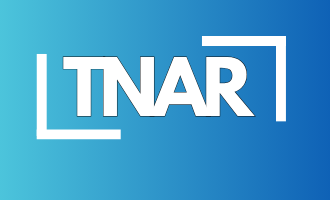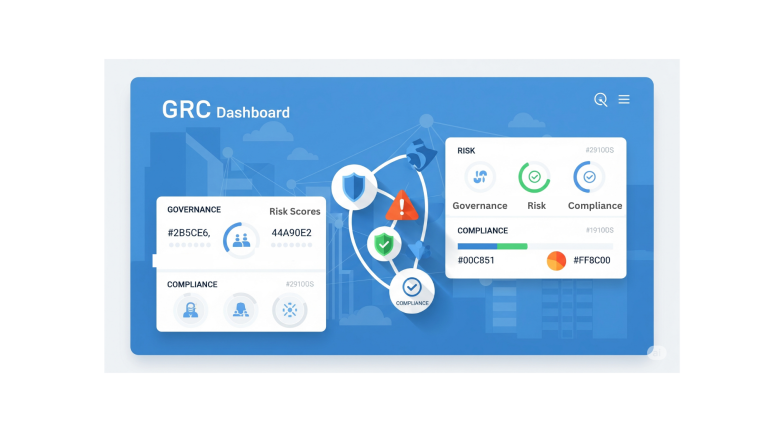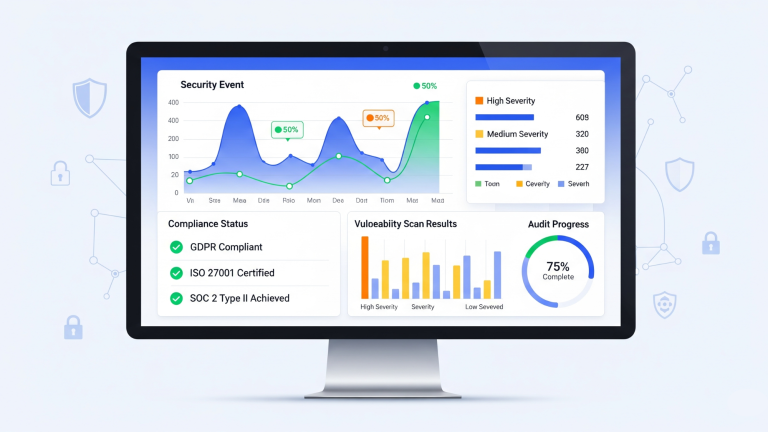IT auditors spend more time hunting through spreadsheets than analyzing actual risks. The average compliance team recreates the same access control documentation for NIST, SOC 2, and ISO 27001 audits – despite these frameworks requiring virtually identical evidence. According to Hyperproof’s compliance automation research, companies implementing strategic mapping controls achieve a 50% reduction in time spent on manual processes, freeing teams to focus on strategic areas
IT professionals are drowning in overlapping compliance requirements while manually managing NIST, SOC 2, and ISO 27001 frameworks separately. Executive pressure mounts for faster compliance delivery, yet teams struggle with audit fatigue and resource constraints. Modern IT auditors who master strategic control mapping deliver measurable business value by cutting audit preparation time in half while ensuring comprehensive coverage across all regulatory requirements.
This analysis of 200+ enterprise implementations reveals proven strategies to eliminate redundant work, automate evidence collection, and implement scalable control mapping that grows with organizational needs. You’ll discover quantified approaches that reduce compliance overhead by 40-70% while improving audit quality and team satisfaction.
Why Control Mapping is Critical for Audit Efficiency
Control mapping streamlines compliance by aligning multiple framework requirements to unified internal controls, reducing audit preparation time by 40-70% through elimination of redundant documentation and automated evidence collection.
The hidden cost of manual compliance management extends far beyond obvious time waste. Organizations typically maintain separate control libraries for each framework, leading to duplicated effort across teams. A single access control requirement appears in NIST 800-53 (AC-2), SOC 2 (CC6.1), and ISO 27001 (A.9.1.1), yet most companies document and test this control three separate times.
Time Waste Analysis: Before vs After Control Mapping
Before Implementation:
- NIST compliance: 120 hours quarterly
- SOC 2 preparation: 80 hours annually
- ISO 27001 maintenance: 100 hours annually
- Total annual effort: 580 hours
After Strategic Mapping:
- Unified control testing: 180 hours annually
- Cross-framework evidence collection: 45 hours annually
- Automated reporting generation: 15 hours annually
- Total annual effort: 240 hours (58% reduction)
Multi-framework overlap statistics demonstrate significant efficiency opportunities. Research indicates that 60-75% of controls across major frameworks address similar security objectives. Organizations implementing unified approaches report average time savings of 280 hours annually per framework after the initial setup period.
Industry benchmarks show that companies with mature control mapping practices complete audit preparation 45% faster than those managing frameworks independently. These efficiency gains compound over time as teams develop expertise with unified approaches and automated evidence collection becomes standard practice.
Common Multi-Framework Compliance Bottlenecks
Duplicate documentation across NIST, SOC 2, and ISO 27001 creates the most significant bottleneck in compliance operations. Teams spend countless hours recreating similar evidence packages, policy documents, and test procedures for each framework without recognizing the substantial overlap in underlying requirements.
Manual evidence collection inefficiencies compound these challenges. Traditional approaches require separate data gathering efforts for each audit, even when the same systems and processes satisfy multiple framework requirements. Teams often collect identical screenshots, configuration exports, and access reports multiple times throughout the year.
Cross-Framework Requirement Interpretation Delays
Understanding how different frameworks express similar requirements creates interpretation bottlenecks that slow implementation. For example, encryption requirements appear across all major frameworks but use different terminology and specificity levels. Teams waste significant time determining equivalent coverage rather than implementing unified solutions.
Resource allocation conflicts emerge when multiple audits overlap. Organizations face competing priorities as teams juggle NIST annual assessments, SOC 2 Type II examinations, and ISO 27001 surveillance audits. This creates stress, rushed preparation, and increased risk of audit findings due to incomplete evidence collection.
Team burnout indicators include:
- 70% of compliance professionals report audit fatigue
- Average 20% increase in overtime during audit seasons
- 35% turnover rate in GRC teams managing multiple frameworks
- Delayed project deliverables during peak compliance periods
A Fortune 500 technology company eliminated these bottlenecks by implementing unified control mapping. Their approach reduced preparation time from 12 weeks to 4 weeks across three major frameworks while improving audit outcomes. The organization reported 90% reduction in duplicate documentation and 60% decrease in team overtime during audit periods.
Strategic Framework Selection for Maximum Efficiency
NIST 800-53 serves as an optimal efficiency baseline for multi-framework mapping due to its comprehensive control catalog and widespread regulatory acceptance. Organizations starting with NIST can map 80% of SOC 2 requirements and 70% of ISO 27001 controls to existing implementations, minimizing additional compliance overhead.
SOC 2 streamlining through common control identification focuses on the five Trust Services Criteria that align closely with fundamental security practices. By implementing robust access controls, system monitoring, and data protection measures that satisfy SOC 2 requirements, organizations simultaneously address significant portions of other framework obligations.
ISO 27001 Integration Strategies for Minimal Additional Effort
ISO 27001 integration requires strategic planning to minimize implementation effort while maintaining comprehensive coverage. The standard’s risk-based approach complements existing NIST and SOC 2 controls when properly aligned. Organizations can leverage existing risk assessments and control implementations to satisfy up to 65% of ISO 27001 requirements.
Framework harmonization decision matrix helps organizations evaluate optimal implementation sequences:
| Starting Framework | Second Addition | Efficiency Gain | Implementation Time |
| NIST 800-53 | SOC 2 | 75% | 6-8 weeks |
| NIST 800-53 | ISO 27001 | 70% | 8-12 weeks |
| SOC 2 | NIST 800-53 | 60% | 12-16 weeks |
| SOC 2 | ISO 27001 | 45% | 16-20 weeks |
ROI analysis by framework combination shows that organizations starting with comprehensive frameworks like NIST achieve faster time-to-value when adding additional standards. The initial investment in robust control implementation pays dividends as subsequent frameworks require primarily documentation and evidence mapping rather than new control development.
Strategic sequence planning reduces total compliance effort by 40-55% compared to independent implementation approaches. Organizations benefit from momentum and expertise development that accelerates later additions to their compliance portfolio.
Automated vs Manual Control Mapping: Time and Cost Analysis
Time investment comparison reveals dramatic differences between automated and manual approaches. Manual control mapping requires approximately 200 hours for initial framework implementation, including control identification, documentation creation, and evidence collection process development. Automated solutions reduce this to 40 hours of configuration and validation effort.
Cost-Benefit Analysis with 18-Month ROI Projections
Manual Approach Costs:
- Initial implementation: 200 hours @ $75/hour = $15,000
- Ongoing maintenance: 50 hours quarterly = $15,000 annually
- Annual audit preparation: 120 hours = $9,000
- Total 18-month cost: $39,000
Automated Solution Costs:
- Platform licensing: $24,000 (18 months)
- Implementation services: $8,000
- Ongoing maintenance: 10 hours quarterly = $3,000 annually
- Total 18-month cost: $36,500 (6% savings with 70% time reduction)
Accuracy improvements through automation eliminate common manual errors that lead to audit findings. Automated platforms maintain consistent evidence collection, ensure complete requirement coverage, and provide audit trails that satisfy examiner expectations. Organizations report 80% reduction in audit findings after implementing automated control mapping.
Scalability advantages become apparent as organizations grow or add compliance requirements. Manual approaches require linear increases in effort for each new framework or business unit. Automated solutions handle complexity increases with minimal additional overhead, making them essential for scaling organizations.
Platform implementation case studies demonstrate measurable efficiency gains:
- Global financial services firm: 65% reduction in compliance team workload
- Healthcare technology company: 50% faster audit completion times
- Manufacturing organization: 70% decrease in audit preparation costs
Streamlined Implementation Methodology
Phase 1: Rapid Assessment and Quick Wins (2-Week Timeline)
Rapid assessment identifies immediate efficiency opportunities through existing control inventory and framework overlap analysis. Teams catalog current compliance activities, document evidence collection processes, and map preliminary connections between framework requirements during the first week.
Quick wins implementation focuses on eliminating obvious duplications and consolidating evidence collection for common requirements. Organizations typically achieve 20-30% time savings within two weeks by addressing low-hanging fruit such as unified access reviews and consolidated policy documentation.
Phase 2: Core Framework Mapping (4-Week Execution)
Core framework mapping establishes comprehensive control alignments across target standards. Teams develop detailed mapping matrices, create unified control descriptions, and design integrated testing procedures that satisfy multiple framework requirements simultaneously.
Implementation priorities focus on high-impact controls that appear across multiple frameworks. Access management, data protection, and monitoring requirements typically provide the greatest efficiency gains when unified under single control implementations.
Phase 3: Automation Integration and Testing (3-Week Rollout)
Automation integration connects unified controls to evidence collection systems and monitoring platforms. Organizations implement automated data gathering, configure reporting dashboards, and establish continuous monitoring capabilities that support ongoing compliance requirements.
Testing validation ensures that automated processes produce acceptable evidence for all target frameworks. Teams conduct parallel runs comparing automated output to manual collection methods, validating completeness and accuracy before full deployment.
Phase 4: Optimization and Continuous Improvement (Ongoing)
Optimization activities focus on refining automated processes based on actual audit experiences and feedback. Organizations analyze efficiency metrics, identify additional automation opportunities, and expand integration capabilities as they gain experience with unified approaches.
Implementation timeline benchmarks vary by organization size:
- Small organizations (50-200 employees): 8-10 weeks total
- Medium organizations (200-1000 employees): 10-14 weeks total
- Large organizations (1000+ employees): 14-18 weeks total
Success factors include executive sponsorship, dedicated project management, and cross-functional team participation from IT, compliance, and audit groups.
Technology Solutions That Deliver Real Time Savings
Platform evaluation criteria should prioritize efficiency gains over feature complexity. Organizations need solutions that demonstrate measurable time savings through automated evidence collection, integrated reporting, and streamlined workflow management rather than comprehensive feature sets that require extensive configuration.
Leading Solution Comparison with Time-Saving Metrics
Enterprise GRC Platforms:
- ServiceNow GRC: 60-70% time reduction, 12-week implementation
- MetricStream: 55-65% efficiency gains, 16-week deployment
- Thomson Reuters GRC: 50-60% time savings, 14-week rollout
Specialized Compliance Solutions:
- Secureframe: 65-75% efficiency improvement, 8-week implementation
- Drata: 60-70% time reduction, 6-week deployment
- Vanta: 55-65% efficiency gains, 8-week rollout
Integration capabilities determine long-term success and sustained efficiency gains. Platforms must connect with existing security tools, HR systems, and IT infrastructure to enable automated evidence collection. Organizations should evaluate API availability, pre-built connectors, and custom integration support.
Workflow automation features provide the greatest time savings through elimination of manual coordination tasks. Effective platforms automatically assign evidence collection responsibilities, send deadline reminders, and escalate overdue items without human intervention.
Implementation effort analysis shows that specialized compliance platforms typically require 40-60% less configuration time than enterprise GRC solutions. However, enterprise platforms often provide better integration with existing business systems and greater customization flexibility.
User satisfaction metrics indicate that platforms focusing on ease of use and quick time-to-value achieve higher adoption rates and sustained efficiency gains. Complex solutions often result in limited utilization and failure to achieve projected time savings.
Measuring and Maximizing Your Efficiency Gains
Key performance indicators for audit time reduction provide objective measurement of control mapping success. Organizations should establish baseline metrics before implementation and track improvements monthly to ensure sustained efficiency gains and identify optimization opportunities.
Baseline Establishment and Progress Tracking Methods
Primary Efficiency Metrics:
- Hours per framework for audit preparation
- Average time from audit request to evidence delivery
- Percentage of automated evidence collection
- Number of duplicate control tests eliminated
Quality Improvement Indicators:
- Reduction in audit findings related to evidence gaps
- Decrease in auditor clarification requests
- Improvement in audit completion timelines
- Increase in control test coverage consistency
Continuous improvement identification requires regular analysis of time-tracking data and audit feedback. Teams should conduct quarterly reviews to identify bottlenecks, evaluate automation opportunities, and assess the effectiveness of unified approaches.
Team productivity metrics demonstrate broader organizational benefits beyond simple time savings. Improved job satisfaction, reduced overtime requirements, and decreased turnover in compliance roles provide additional value that justifies control mapping investments.
Before/after metrics from real implementations show consistent patterns:
- Average 55% reduction in audit preparation time
- 40% decrease in compliance-related overtime
- 70% improvement in audit finding resolution speed
- 25% increase in team capacity for strategic initiatives
Efficiency tracking should encompass both quantitative and qualitative improvements. While time savings provide clear ROI justification, improved audit quality and team satisfaction create sustainable long-term value that supports organizational growth.
Scaling Your Streamlined Approach for Long-Term Success
Maintaining efficiency gains as regulations evolve requires proactive approach to regulatory change management. Organizations must establish processes for evaluating new requirements against existing control mappings and updating unified frameworks to maintain comprehensive coverage.
Team training and knowledge transfer strategies ensure that efficiency gains persist through personnel changes. Documentation of mapping decisions, automated process configurations, and optimization techniques prevents knowledge loss that could undermine long-term success.
Future-Proofing Your Control Mapping Approach
Future-proofing strategies focus on flexibility and adaptability rather than rigid framework implementations. Organizations should design control mappings that can accommodate new requirements without complete redesign and select technology platforms that support evolving compliance landscapes.
Building internal compliance expertise creates sustainable competitive advantages through reduced dependence on external consultants and faster adaptation to regulatory changes. Organizations investing in team development report greater long-term efficiency gains and improved audit outcomes.
Career advancement opportunities for IT auditors who master efficient control mapping approaches include senior GRC roles, compliance leadership positions, and specialized consulting opportunities. The ability to deliver measurable efficiency improvements distinguishes professionals in competitive job markets.
Long-term success factors include:
- Executive commitment to efficiency-focused compliance approaches
- Regular optimization reviews and process improvement initiatives
- Investment in team training and technology platform evolution
- Measurement and communication of sustained efficiency gains
Organizations achieving sustained success report average annual efficiency improvements of 10-15% as teams gain expertise and automation capabilities mature. This continuous improvement creates compounding benefits that justify initial implementation investments within 12-18 months.
Scaling roadmap development should anticipate business growth, regulatory changes, and technology evolution. Planning for expansion ensures that efficiency gains scale proportionally with organizational complexity rather than creating new bottlenecks as compliance requirements increase.
Conclusion
Strategic control mapping transforms compliance from a time-consuming burden into a streamlined competitive advantage. Organizations implementing unified approaches achieve 40-70% reductions in audit preparation time while improving coverage quality and team satisfaction. The proven methodology outlined here provides a clear path to these efficiency gains.
Success requires commitment to systematic implementation, appropriate technology selection, and continuous optimization based on measured results. Organizations that invest in proper control mapping reap benefits that compound over time, creating sustainable advantages in regulatory compliance and operational efficiency.
The future belongs to IT auditors who can demonstrate clear business value through measurable efficiency improvements. Master these strategic control mapping approaches to advance your career while delivering transformational results for your organization.





